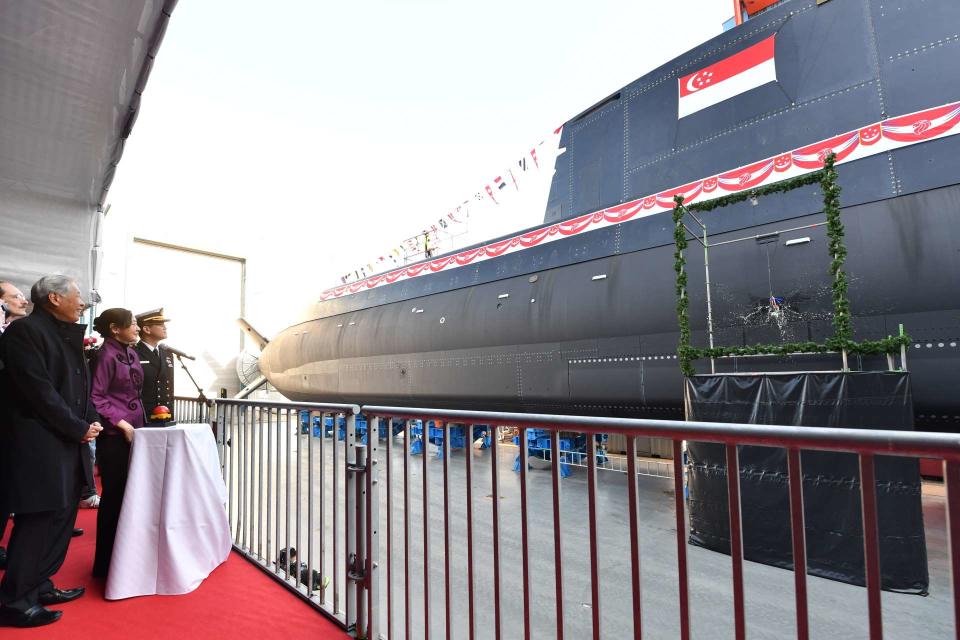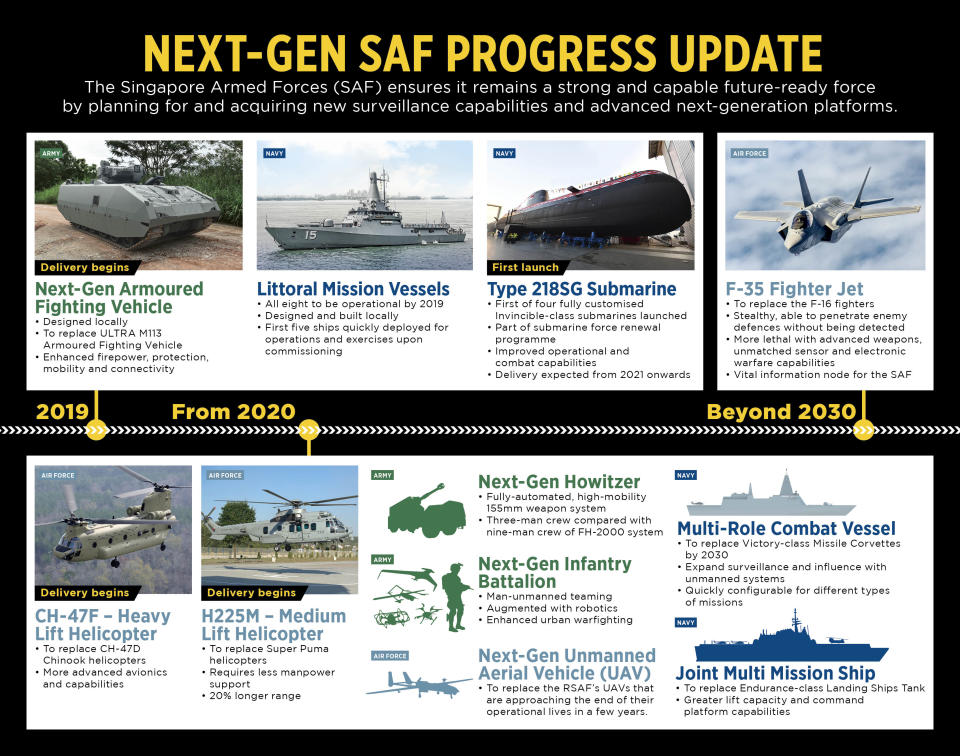Budget 2019 debate: 'Next-generation' SAF upgrades in land, air, sea forces to guard Singapore's future

The push to build Singapore’s “next-generation” military is “progressing well” and will see upgrades to the nation’s land, sea and air forces.
This will include the purchase of state-of-the-art F-35 fighter jets and “Invincible”-class submarines; the deploying of new armoured fighting vehicles; and the use of more unmanned platforms by the Singapore Armed Forces (SAF).
“In all, the Next-Generation SAF of 2030 and beyond, with this full complement of assets in air, land and sea, will be able to defend Singapore for another generation,” said Defence Minister Ng Eng Hen, who announced the SAF’s plans during the Ministry of Defence’s (Mindef) Committee of Supply debate in Parliament on Friday (1 March).
“This is the SAF that will take us into and guard our future.”
In the air

To upgrade the Republic of Singapore Air Force (RSAF), Mindef will look to replace its current fleet of F-16s – which face “obsolescence post-2030” – with F-35 fighter jets, said Dr Ng.
Mindef will issue a Letter of Request to the United States for the purchase of four F-35s, with the option to purchase eight more if plans proceed further.
Each F-35 will cost between US$90 million (S$122 million) and US$115 million, said Ng, adding that this was comparable to what was paid for Singapore’s current F-15SG fighter jets. Mindef will also work with the US Department of Defence to “optimise operating and maintenance costs”.
Noting that the aircraft’s price had been steadily falling due to healthy orders from the US and 10 other countries, Dr Ng said the Defence Science and Technology Agency (DSTA) had deemed it an opportune time for Singapore to put in a purchase request.
“Singapore has the endorsement of both the US Administration and the Department of Defence for our proposed purchase of F-35s,” he added.
“In fact, (US) President (Donald) Trump wrote to (Prime Minister Lee Hsien Loong) last month welcoming Singapore’s plans to acquire the F-35.”
The RSAF will also take delivery of new helicopters from 2020, including H225M medium-lift and CH-47F heavy-lift choppers.
“These new helicopters will add capacity and be more effective in Search and Rescue or Humanitarian Assistance and Disaster Relief operations,” Dr Ng said.
At sea

Mindef will replace its current submarine fleet with four new “Invincible”-class submarines – the first of which was launched recently in Germany.
They will feature longer endurance as well as the latest sensors and automated systems developed for use in regional waters. The full fleet is expected to be ready by 2025.
The Republic of Singapore Navy’s (RSN) missile corvettes, which have served since 1989, will also be replaced with new Multi-Role Combat Vessels (MRCVs). Equipped with more air and sea drones, the first of these will be delivered around 2025, with full delivery expected by 2030.
“More than just improving capabilities, the new Multi-Role Combat Vessels will need less manpower, about half the size of that found on other modern frigates,” said Dr Ng.
“This is possible as the Multi-Role Combat Vessels were custom-built for lean manning, aided by technologies which automate many functions such as maintenance.”
Dr Ng added that there will be cost savings of up to 10 per cent in operating the MRCVs, compared with other similar-sized frigates.
The RSN’s Landing Ship Tanks – the navy’s “workhorse in humanitarian assistance and disaster relief and other mission” – will also be replaced over the coming decade with larger and more flexible Joint Multi-Mission Ships.
Observing how the 2008 Mumbai terror attack “showed the devastating destruction that can come from the sea”, Dr Ng said that the SAF would be looking to “beef up security for our entire coast”.
In doing so, the SAF will add more optical sensors and coastal radars to detect and deter potential threats.
“More unmanned watch towers will be added for better coverage of the busy traffic across the Singapore Strait. We will also add unmanned surface vessels to patrol our waters, beginning next year,” said Dr Ng.
On land

From this year, the Army’s current M113 Ultras will be replaced by the Next-Generation Armoured Fighting Vehicles as the mainstay of the SAF’s mechanised forces.
“Singaporeans will see them soon on our roads at this year’s National Day Parade,” said Dr Ng, who added that the new vehicles have better armour and mobility through urban environments.
Another addition to the Army will be the Next-Generation Howitzers, which feature extended range and greater precision.
Building a leaner, ‘hybrid’ military

The SAF will also become a “more hybrid force” with the use of more unmanned platforms, said Dr Ng.
In this regard, some of the RSAF’s ageing Unmanned Aerial Vehicles (UAVs) will be replaced, while the RSN’s new MRCVs will also be equipped with unmanned surface vessels.
“Soldiers within the Army will soon use micro-UAVs for the first time, particularly useful in dense built-up urban environments,” said Dr Ng.
“These unmanned platforms will complement traditional manned equipment, to enhance responses across the full range of operational scenarios.”
Noting that the SAF will face a manpower supply reduction of about one-third by 2030, Ng said that much of the new technology to come has been designed to be operated with fewer troops.
“The modern systems and platforms of the SAF can also be operated by NSmen who are not PES A or B, and therefore effectively increase our utilisation of our manpower pool,” said Dr Ng.
Defence expenditure to ‘even out’
Dr Ng said that defence spending is expected to grow 3 per cent to 4 per cent each year over the next decade to “at least keep pace with inflation”.
“This commitment holds despite the slightly higher increase at around 4.8 per cent this year, as certain projects or acquisitions have matured simultaneously,” he added. Singapore’s defence spending rose 3.9 per cent to $14.76 billion in 2018 from $14.2 billion in 2017.
Despite the rise, Dr Ng said Singapore’s overall defence expenditure will “even out in subsequent years”.
Other Parliament stories
Budget 2019 debate: SAFTI City, new NS Hub by 2023, says Ng Eng Hen
Budget 2019 debate: NSmen no longer need to notify authorities of overseas trips under 6 months



